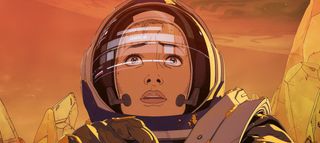
With its NSFW collection of science fiction dreams and nightmares, Netflix's Emmy Award-winning animated anthology, Love, Death + Robots, is one of the most provocative offerings from the streaming giant.
The latest volume of "Love, Death + Robots" recently kicked off its third, and possibly the best, season to date on May 20 with a sublime selection of animation gems from all corners of the universe.
David Fincher ("Se7en," "Alien 3," "Fight Club") and Tim Miller ("Deadpool") have been executive producing this imaginative series since it first debuted on Netflix back in March 2019.
- Want to try Netflix? You can get a 30-day free trial now
- Sign up for Netflix starting at $8.99/month.
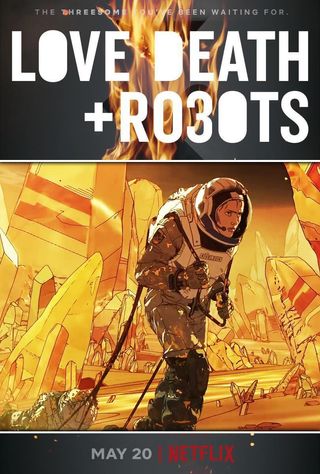
Check out our list for the best free sci-fi short movies and find out our picks for the best sci-fi movies of all time!
Volume 3 offers daring viewers a menagerie of monster crabs, rampaging zombies, a cyborg Grizzly, insectoid aliens, wise-cracking robots, demonic river spirits, evolved rats, an evil elder god, and an astronaut feeling brain-altering effects of painkillers on Jupiter's hostile moon of Io.
Filmmaker Emily Dean ("The Lego Batman Movie") directs the third segment of "Love, Death + Robots Vol. 3" with her hallucinatory short, "The Very Pulse of the Machine," and it's a finely-crafted valentine to legendary French illustrator Moebius (Jean Giraud) that never fails to deliver.
Adapted by writer Philip Gelatt and based on the Hugo Award-winning short story by sci-fi legend Michael Swanwick, "The Very Pulse of the Machine" is a poetic, trance-like journey of outer space exploration. Its evocative title comes from a line in William Wordsworth's love poem "She's a Phantom of Delight," published in 1807 and written for his wife Mary Hutchinson.
Polygon Pictures, which was the first Japanese studio to participate in the Netflix series, provides the startling '90s style animation that conveys the perfect retro psychedelic tone.
Get the Space.com Newsletter
Breaking space news, the latest updates on rocket launches, skywatching events and more!
The plotline of Dean's sci-fi fever-dream opens with a lunar rover crashing on the dangerous surface of Jupiter's moon, Io. Astronaut Martha Kivelson must haul her co-pilot Juliet Burton's dead body across the inhospitable terrain back to the lander while under the influence of pain-reducing narcotics that lead her to question reality and the true nature of the Jovian satellite.
Space.com spoke with Dean on directing "The Very Pulse of the Machine," what she hoped to add to the evolving legacy of "Love, Death + Robots," and delivering a moving ode to Moebius.

Space.com: How did you choose the award-winning source material for your segment?
Emily Dean: I was invited in to read a bunch of short stories that they were considering for Volume 2 back three years ago in 2019, and I chose "The Very Pulse of the Machine." It was originally meant to be for Volume 2, but the process took so long that it ended up being in Volume 3.
Space.com: What elements of the story struck you as being perfect for this animation anthology?
ED: I was drawn to it because of its fantastical element, which really excited me creatively. But I loved the metaphysical, ambiguous ending. That's something that for me creatively, I like to claim in my work, that kind of quasi-spiritual sci-fi. The other component was bringing a certain visual style to the project, and from my very first pitch I wanted this to be a love letter to Moebius. I felt that his style would fit this story perfectly.
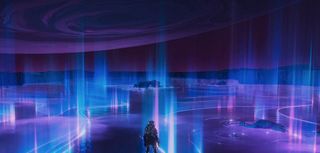
Space.com: How was the vivid color palette decided upon with the animators at Polygon?
ED: I'm attracted to heightened color, and a heightened sensory experience that color can bring. What was a fun thing to play with is that the element of sulfur (and Io is a sulfurous moon) is yellow when it's in its solid state, and when heated and melted in a liquid state it becomes this bluish purple color. And I thought let's use that as the basis of our color palette.
The story was mapped out to be this day-to-night transition and that was very intentional because I wanted to show something on the surface, when you look at it one way, can be very different to the way you see it underneath, at a different time of day. The colors are to reflect the change in Martha's own perception of what she understands to be sentient life.
It was really a back and forth of trying to find that stylistic synthesis between the "clean line" French influence and the Japanese influence of anime, so we kind of found a hybrid of the two.
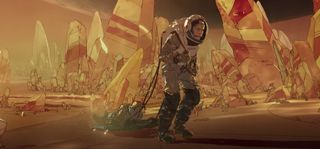
Space.com: What inspirations did you draw from to craft "The Very Pulse of the Machine"?
ED: My godmother is actually an astronomer and she worked on the Hubble Space Telescope and she worked closely with the European Space Division. So I think from an early age, hanging out with my Italian godmother, who is very cool, that really opened my mind to what's out there in space.
For filmmaking inspirations, definitely "Solaris," "2001: A Space Odyssey," and "Contact," which was another film I really loved growing up. Also, "The Abyss," which was a film I believe Moebius worked on. From a fantastical standpoint I'd say for other inspirations growing up in Australia, I watched a lot of George Miller and Peter Weir. And I'm still hugely in love with "The Lord of the Rings Trilogy" by Peter Jackson, even though he's not Australian.
Space.com: NASA is set to land the first woman on the Moon with its upcoming Artemis mission. With Kivelson as your film's female protagonist, how did that factor into your choice of material to animate?
ED: I wanted to portray a female character that we've seen a lot in live-action sci-fi movies. She's tougher, she's highly intelligent, she's a scientist and is very competent, facing unimaginable challenges. I felt like it was a character we haven't seen in animation, certainly in American animation. To me she's like a representative of humanity speaking to this sentient consciousness of Io and I thought it would be very beautiful if it was a woman.
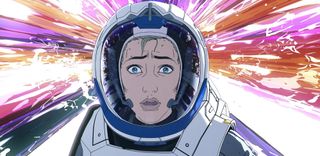
Space.com: Your vocal performers, Mackenzie Davis (Kivelson) and Holly Jade (Burton), lend the ideal inflections and emotion to their roles. How were they chosen and why?
ED: I knew we wanted Mackenzie from the very beginning. She just has this incredible presence and strength in all of her work. And Holly, she's fantastic. She's an Australian actress and we found her through listening to a lot of auditions. She really stood out because she had this aching beauty to her voice, and because she had to speak not only for Juliet Burton but also for the voice of Io trying to find her words through poetry. So we needed something very specific and we're so thrilled that we found her.
I'm just waiting to see how the world receives "The Very Pulse of the Machine" and I'm so glad that I got a chance to make it.
"The Very Pulse of the Machine" is currently streaming as part of "Love, Death + Robots Vol. 3" exclusively on Netflix.
Follow us on Twitter @Spacedotcom or on Facebook.
Follow us on Twitter @Spacedotcom and on Facebook.
Join our Space Forums to keep talking space on the latest missions, night sky and more! And if you have a news tip, correction or comment, let us know at: community@space.com.

Jeff Spry is an award-winning screenwriter and veteran freelance journalist covering TV, movies, video games, books, and comics. His work has appeared at SYFY Wire, Inverse, Collider, Bleeding Cool and elsewhere. Jeff lives in beautiful Bend, Oregon amid the ponderosa pines, classic muscle cars, a crypt of collector horror comics, and two loyal English Setters.
Most Popular


